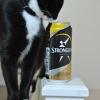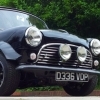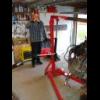
Body Panel (Welding Versus Riveting)
#1

Posted 07 August 2012 - 04:06 PM
#2

Posted 07 August 2012 - 04:10 PM
And avoid oversills
#3

Posted 07 August 2012 - 04:11 PM
Even if it were legal I certainly wouldn't want to be driving round with that underneath me.
#4

Posted 07 August 2012 - 04:25 PM
#5

Posted 07 August 2012 - 04:26 PM
#6

Posted 07 August 2012 - 04:41 PM
Would be easy to replace rusty panels thou.
Regards
Clifford
#7

Posted 07 August 2012 - 04:45 PM
The main objection to riveted panels on cars is that they are generally seen as a bodge (soft alloy rivets, overlarge holes a 'cover-up' coating to get them past an unknowing buyer or an MOT inspector). That said, many early cars had riveted bodies on solid chassis.
I don't doubt that using aircraft standard adhesives and engineering practices, panels could be replaced which would be as strong or even stronger than welded ones, but I don't believe they would be acceptable for a UK MOT inspection.
Bob
#8

Posted 07 August 2012 - 04:57 PM
That said, a battery box doesnt have much structural purpose...
#9

Posted 07 August 2012 - 05:05 PM
#10

Posted 07 August 2012 - 05:15 PM
But there is NO, repeat, NO other panel on a Mini shell which can safely be rivetted. All are stressed parts of the monocoque.
There is very little similarity between rivetting aircraft and cars. The materials and stresses are very different. There are stresses in parts of the shell that could never be sustained by a rivetted aluminium alloy structure, at least not for very many fatigue cycles, whereas mild steel copes with fatigue very well. Aircraft alloy rivets would rapidly fail in a car.
Of course, you could, from the structural point of view, use old fashioned mild steel rivets, inserted red hot and shaped with suitable hammers, one where each spot weld would have been. It would still be an instant MOT fail.
There are a few places where a seam weld is used in a Mini (also compulsory for any patial panel replacements), and you could never replicate that by rivetting, so to do any serious body repairs a MIG welder is essential, amd far easier to use than rivetting anyway. No need to prepare exact size holes, for example.
#11

Posted 07 August 2012 - 05:18 PM
But yeah, rivited floor probably isnt a good idea
#12

Posted 07 August 2012 - 05:20 PM
What kind of rivets did you use?I dont know about floor panels but i rivited in my new battery box as I dont have access to welding equipment and seeing as how it was spot welded to start with i figured it would be ok.
That said, a battery box doesnt have much structural purpose...
#13

Posted 07 August 2012 - 06:15 PM
just add winter salt water
#14

Posted 07 August 2012 - 06:47 PM
#15

Posted 07 August 2012 - 07:52 PM
Hi loks would be of no use on floor panels as you would have to overlap and then it would need to be a double row. So that then leads onto solid rivets. Now you will have to use Monel rivets and again a minimum of two rows but more than likely three. So if you were to go this route from a strength point of view you will to use 3/16 mush heads so tooling will need to be a 4x with a good heavy block. Compressor needed then.
Now i know exactly what you are on about with regards to strength using rivets, Hi loks, cherrys etc but a car monocoque is normally designed with all the various stress loadings passed through the structure via welded joints etc and this design is then signed off as being acceptable, the same as aircraft. A welded joint on a car has been designed that way and is the recognised way of joining all of the items together. By riveting you are deviating away from that accepted method and so without testing under the correct conditions then you cannot say just how well riveting will join the items together.
I wont wittle on about sphere of influence etc etc as although applicable on aircraft it would not be on a car as unless its been designed to be riveted together, so unless you are an aircraft engineer not many people will know what i'm on about.
So as far as you are concerned its welding and nothing else will be acceptable. If you do use rivets and then hide them with sealant you are running an unacceptable risk not only to yourself but to any passengers you may carry in your car. If a MOT tester sees something he finds suspicious then he will more than likely fail it. Is it worth the grief??
1 user(s) are reading this topic
0 members, 1 guests, 0 anonymous users



















